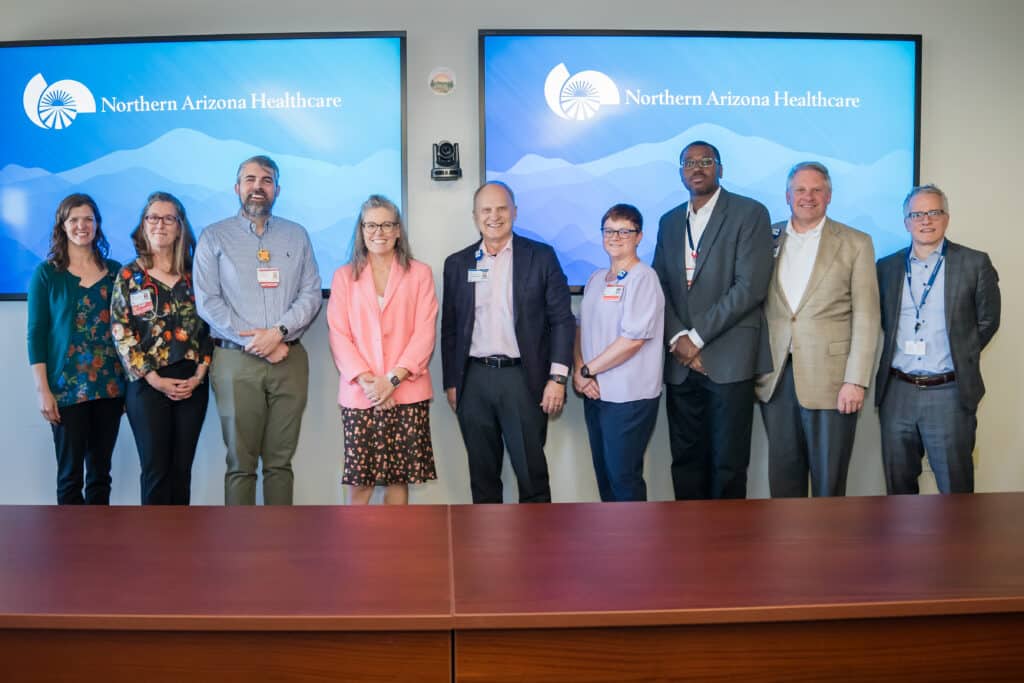Arizona Gov. Katie Hobbs visited Flagstaff Medical Center on June 12 to see how Northern Arizona Healthcare (NAH) serves a rural population that utilizes Medicaid, and to meet with staff and providers to understand how proposed Medicaid funding cuts could impact the care NAH can provide.
Hobbs requested the visit after a conversation in late May with several health care executives, including NAH Chief Executive Officer Dave Cheney. During that meeting, Cheney shared how the proposed cuts could have a greater impact on rural residents because rural communities generally rely on Medicaid funding more than urban communities.
In addition, tribal communities rely on Medicaid coverage and the special provisions carved out as part of Indian Health Services, so the cuts could have an outsized impact on FMC, where about 33 percent of patients are from tribal communities.
“Reductions to the Medicaid program could have a damaging effect on the availability of essential health care services for all people who live in our rural communities, regardless of whether they’re covered by Medicaid,” Cheney said. “Because Northern Arizona Healthcare serves as the primary health care provider for the region, spanning from the Verde Valley to the Four Corners, covering many rural and tribal communities, cuts to Medicaid could hinder rural non-profit systems like NAH from delivering a full range of services.”
Such cuts could have the impact of forcing systems to like NAH to reduce services to make up for providing care to those who become uninsured, causing a reduction in health care services available to anyone in the region.
In addition, losing insurance can cause patients to delay care, several NAH colleagues told Hobbs.
And the impact is not just to FMC, said Bo Cofield, NAH chief operating officer.
“About 60 percent of patients at VVMC have chronic conditions and they are at the hospital because of a paucity of care in the community. If that’s the current state…losing funding makes that worse,” Cofield said.
Hobbs met with providers throughout the hospital system and discussed the potential Medicaid funding cuts with providers including Brandon Abbott, DO, MPH, FAAP, hospitalist/pediatrics; Andrew Atiemo, MD, interventional cardiology; Diana E. Holt, MN, RN, PPCNP-BC, lead CHC pediatric nurse practitioner; Colleen Little, manager of pediatric unit and the pediatric ICU; Rachel Levitan, MD, interim chief medical officer and emergency room physician; Pasquale Bernardi, MD, president of NAH Medical Group; plus Cheney and Cofield.
Because FMC cares for any patient who seeks care, regardless of insurance status or ability to pay, an increase in uninsured patients due to Medicaid coverage cuts could also reduce the volume of patients NAH can care for.
When a patient needs to be transferred to a lower level of care at another facility, lack of insurance can delay that, Little said.
“If our patients cannot safely discharge, they continue to occupy beds and prevent access for others,” she said.
And the impact extends beyond hospital care, said Holt. NAH’s Children’s Health Center often sees patients who are dealing with chronic illnesses, who need multiple medications, many health care services and specialists, and social services provided by NAH. Losing insurance can cause them to delay care for financial reasons, and Holt said she has seen the devastating results of delayed care.
“They’re really challenging cases, and when they have gaps in their care they can really suffer quickly and significantly. It’s critical and their lifeline,” Holt said.
Hobbs shared her concern with the proposed cuts is driven by the knowledge that any reductions in Medicaid coverage can’t be covered by another funding source.
“In the state budget, we don’t have the funds to back fill it. We’re doing everything we can to try to stop these cuts,” she said. Cheney thanked her for her support and advocacy on behalf of all of NAH.
Cofield also shared that caring for an increased number of uninsured patients who are unable to pay for their care means NAH could be forced to delay expansions of services, facility upgrades and more, all of which would cause a reduction in care for the entire community. He and Levitan talked about how those factors can cause NAH to fall behind on recruitment and retention, again reducing care for the entire community, including those with commercial insurance who may assume they would be unaffected by proposed Medicaid cuts in coverage.
NAH is working diligently with the Health Systems Alliance of Arizona, and other lobbying groups, to ensure lawmakers understand the deep impact of Medicaid cuts on everyone who relies on having a strong health care system available.

